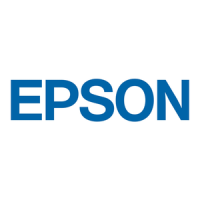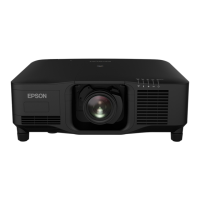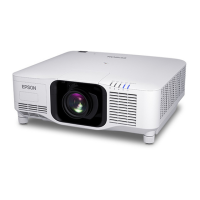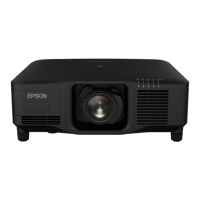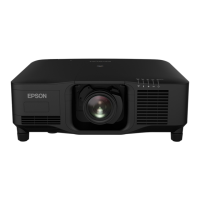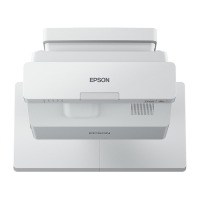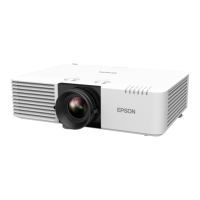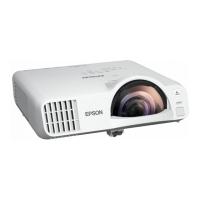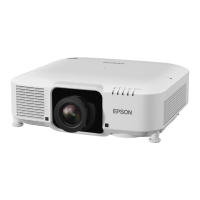
Do you have a question about the Epson EB-PU1006W and is the answer not in the manual?
| Matrix size | 0.76 \ |
|---|---|
| Heat dissipation | 1247.8 BTU/h |
| Number of colors | 1.07 billion colors |
| Native aspect ratio | 16:10 |
| Projection technology | 3LCD |
| Contrast ratio (typical) | 2000:1 |
| Screen size compatibility | - \ |
| Projector native resolution | WUXGA (1920x1200) |
| Keystone correction, vertical | -45 - 45 ° |
| Keystone correction, horizontal | -30 - 30 ° |
| Projector brightness (economic mode) | 4200 ANSI lumens |
| Light source type | Laser |
| Service life of light source | 20000 h |
| Service life of light source (economic mode) | 30000 h |
| Throw ratio | 0.35 - 10.11:1 |
| Focal length range | varies by lens mm |
| Interchangeable lens | Yes |
| 3D | No |
| Video processing | 10 bit |
| Video color modes | Cinema, Dynamic, Natural, Presentation, DICOM simulation mode, Multi-projection, BT.709 |
| Analog signal format system | Not supported |
| Serial interface type | RS-232C |
| USB 2.0 ports quantity | 2 |
| Noise level | 30 dB |
| Country of origin | Philippines |
| Noise level (economic mode) | 28 dB |
| Placement | Ceiling, Desktop, Flying frame |
| Product type | Large venue projector |
| Product color | White |
| Market positioning | Presentation |
| Cable lock slot type | Kensington |
| Power source | AC |
| AC input voltage | 100-240 V |
| AC input frequency | 50 - 60 Hz |
| Power consumption (standby) | 0.5 W |
| Power consumption (typical) | 367 W |
| Power consumption (economy mode) | 310 W |
| Storage temperature (T-T) | -10 - 60 °C |
| Storage relative humidity (H-H) | 10 - 90 % |
| Operating relative humidity (H-H) | 20 - 80 % |
| Bundled software | Inhalt DIY-App, EasyMP Multi PC Projection, Epson Projektor Content Manager, Epson Projektor Management, Epson Projektor Professional Tool |
| Supported network protocols | HTTPS, IPv6, SNMP, ESC/VP.net, PJLink |
| Software support | via: Crestron Integrated Partner, Extron IP Link, Extron XTP, AMX Device Discovery |
| Pallet weight | 0 g |
| Quantity per pack | 1 pc(s) |
| Quantity per pallet | 14 pc(s) |
| Harmonized System (HS) code | 85286200 |
| Depth | 436 mm |
|---|---|
| Width | 545 mm |
| Height | 189 mm |
| Weight | 15400 g |
| Package depth | 760 mm |
| Package width | 561 mm |
| Package height | 265 mm |
| Package weight | 20604 g |
Lists special features like resolution, 4K enhancement, 3LCD technology, and connectivity.
Lists the items included in the projector's packaging for shipping and setup.
Lists optional components that may be needed depending on usage plans.
Details software and manuals required for projector setup and operation.
Lists optional accessories and replacement parts available for purchase.
Information on projector warranty and how to register the product.
Explains the meaning of warnings, cautions, notes, and tips used in the manual.
Illustrates and identifies the various parts and ports on the projector.
Guidance on selecting a location and mounting the projector for optimal viewing.
Information on determining the optimal distance between the projector and screen for image size.
Instructions for connecting various video sources and external speakers to the projector.
Step-by-step guide for installing and detaching interchangeable projector lenses.
Steps for connecting and projecting via a wired Ethernet network.
Guide to setting up and using wireless network projection with the projector.
How to access and control projector settings via a web browser interface.
Steps for powering on the projector and initial startup procedures.
Instructions for properly shutting down the projector.
Adjusting the projected image sharpness using the focus controls.
Using lens shift to fine-tune the projected image position without moving the projector.
Correcting geometric distortions for a rectangular projected image.
Selecting different color presets for optimal image appearance.
Modifying the projector's brightness level for various environments.
Magnifying specific parts of the projected image for detailed viewing.
Setting up passwords, button locks, and security cables to protect the projector.
Accessing and configuring advanced image processing settings.
Manually aligning red and blue color channels for accurate image display.
General steps for combining images from multiple projectors for a larger display.
Creating a single large image by projecting from multiple projectors side-by-side.
Creating a seamless image by blending the edges of projected images from multiple projectors.
Transferring projector configuration settings to other projectors.
Navigating the projector's on-screen menu system to change settings.
Adjusting core image parameters like color, brightness, contrast, and sharpness.
Configuring settings related to input resolution, aspect ratio, and signal type.
Procedures for cleaning and maintaining the projector for optimal performance.
Steps for replacing the batteries in the remote control unit.
Guidelines for safely packing, shipping, or storing the projector.
Basic troubleshooting steps for common projector operational issues.
Interpreting indicator lights to diagnose projector status and errors.
Troubleshooting common issues related to projected images and audio output.
Steps to resolve issues where no image is displayed on the screen.
Troubleshooting steps for resolving the "No Signal" error message.
Steps to improve image clarity when the projection appears fuzzy or blurry.
Addressing operational issues with the projector or its remote control.
Troubleshooting common issues encountered when connecting the projector to a network.
Key technical details about the projector's display, resolution, lens, and color reproduction.
Lists compatible display formats, refresh rates, and resolutions.
Critical safety warnings regarding laser light, electrical hazards, and product handling.
Essential safety guidelines for setting up, using, and maintaining the projector.
